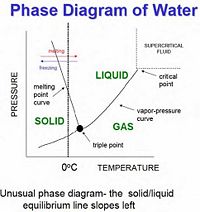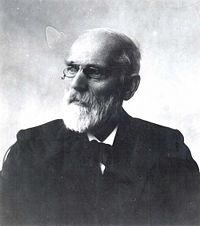PHZ3400 Phase Transition: Difference between revisions
MatthewHoza (talk | contribs) |
MatthewHoza (talk | contribs) |
||
| Line 43: | Line 43: | ||
<math>a</math> is the measure of attraction between particles | <math>a</math> is the measure of attraction between particles | ||
<math>b</math> is the volume excluded by a mole of particles | <math>b</math> is the volume excluded by a mole <font color=red> (not sure what this means)</font> of particles | ||
Revision as of 15:39, 28 January 2009
Phases of Matter
Matter can exist in many phases. The phases most common are solids, liquids, and gases. In Physics, a phase can be described as a region of space in which all physical properties of a material remain constant, or uniform. Having consistent physical properties and chemical uniformity allow one to distinguish between the various phases, or states of matter.
Gas-Liquid-Solid Phase Diagram
When studying phase transitions, it is important to be able to read and understand a phase diagram. A phase diagram is a pressure vs. temperature graph of an element or compound that shows which phase we can expect it to be in (see right for example). The lines represent the boundaries between phases, and at any point on these lines we can expect two (or even three) phases to exist simultaneously in equilibrium. In the area between curves only one phase of matter exist. There are two important points on phase diagrams which should be mentioned:
Triple Point - At this specific temperature and corresponding pressure, the three phases of matter can exist simultaneously in equilibrium. This means that evaporation, condensation, freezing, melting, fusion, and sublimation are happening at once.
Critical Point - At this point in temperature and pressure (and at any point above this), the boundary between liquid and gas doesn't exist any more. Here a gas cannot be distinguished from a liquid, and the heat of vaporization is zero. However, you can still have a smooth transition between gas and liquid by going up and around the critical point (as seen on the phase diagram) by passing through the supercritical fluid region.
Phase Separation and Nucleation
This we'll cover on Friday, Jan. 30
Why Ice Floats? Consequences.
Van der Waals Equation
The Van der Waals Equation is an equation of state, that is a modification of the ideal gas law,
, that takes into account the non-zero size of particles as well as attractive forces (Van der Waals Force) felt between them.
Johannes van der Waals proposed two modifications to the ideal gas law:
Van der Waals Equation:
where
is pressure
is temperature
is the number of particles
is volume of the container containing the fluid
is the measure of attraction between particles
is the volume excluded by a mole (not sure what this means) of particles











